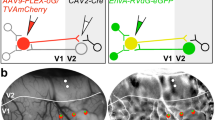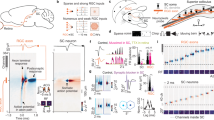Summary
In the first visual ganglion of the fly (Musca domestica) there are many similar visual channels (“cartridges”), connected to each other by various systems of fibers, the most regular of which consists of the collateral branches of the L4 neuron, which is contained in each cartridge.
The three collaterals of L4 run to three different cartridges, one of which is the parent cartridge of the neuron, the other two being neighbours of that cartridge in two directions of an hexagonal array (Figs. 1a, 3).
Within each cartridge there are thus the endings of three collaterals (from three different L4 neurons). These make close physical contact, and serial sectioning shows that each collateral is presynaptic to the other two (Fig. 2). It follows that there are reciprocal synapses between any pair of these collaterals.
The network of relationships thus set up is the simplest scheme of coupling in a hexagonal array (Fig. 1a, b, c).
Similar content being viewed by others
References
Boschek, C. B.: On the fine structure of the peripheral retina and Lamina ganglionaris of the fly,Musca domestica. Z. Zellforsch.118, 369 (1971)
Braitenberg, V.: Patterns of projection in the visual system of the fly. I. Retina-Lamina projections. Exp. Brain Res.3, 271 (1967)
Braitenberg, V.: The anatomical substratum of visual perception in flies. A sketch of the visual ganglia. In: Rendiconti S.I.F. XLIII (ed. by Reichardt, W.). London and New York: Academic Press 1969
Braitenberg, V.: Ordnung und Orientierung der Elemente im Sehsystem der Fliege. Kybernetik7, 235 (1970)
Campos-Ortega, J. A., Strausfeld, N. J.: The L4 monopolar neuron: a substrate for lateral interaction in the visual system of the flyMusca domestica. Brain Res.59, 97 (1973)
Kirschfeld, K.: Die Projektion der optischen Umwelt auf das Raster der Rhabdomere im Komplexauge vonMusca. Exp. Brain Res.3, 248 (1967)
Rall, W., Shepherd, G. M., Reese, T. S., Brightman, M. W.: Dendrodendritic synaptic pathway for inhibition in the olfactory bulb. Exp. Neurol.14, 44 (1966)
Strausfeld, N. J., Braitenberg, V.: The compound eye of the fly (Musca domestica): Connections between the cartridges of the Lamina ganglionaris. Z. vergl. Physiol.70, 95 (1970)
Trujillo-Cenóz, O., Melamed, J.: Electron microscope observations on the peripheral and intermediate retinas of dipterans. In: The functional organization of the compound eye (C. G. Bernhard, ed.). London: Pergamon Press 1966
Vigier, P.: Mécanisme de la synthese des impressions lumineuses recueillies par les yeux composés des Diptères. C. R. Acad. Sci. (Paris)122 (1907)
Zettler, F., Järvilehto, M.: Lateral inhibition in an insect eye. Z. vergl. Physiol.76, 233 (1972)
Author information
Authors and Affiliations
Rights and permissions
About this article
Cite this article
Braitenberg, V., Debbage, P. A regular net of reciprocal synapses in the visual system of the fly,Musca domestica . J. Comp. Physiol. 90, 25–31 (1974). https://doi.org/10.1007/BF00698364
Received:
Issue Date:
DOI: https://doi.org/10.1007/BF00698364




